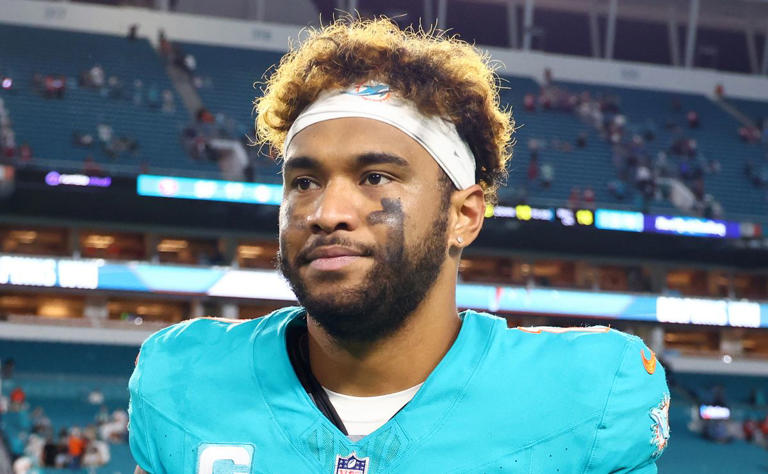NFL News: Dolphins Start Huge Rebuild by Parting Ways with Three of Tua Tagovailoa’s Teammates
The Miami Dolphins have taken a bold step toward a massive rebuild, parting ways with three key teammates of quarterback Tua Tagovailoa in an effort to reshape their roster for the future. As the Dolphins look to find sustained success, the decision to move on from these veteran players signals a shift in both their strategy and direction as they continue to navigate the competitive landscape of the NFL.
In what may be one of the most significant roster overhauls in recent memory, the Dolphins have made it clear that they are willing to make tough decisions in order to create financial flexibility and build a team that can compete at the highest level. The three players released or traded – two offensive and one defensive – all played major roles in the franchise’s recent history but have now been deemed expendable as Miami transitions into a new phase under head coach Mike McDaniel’s system.
Let’s take a closer look at the players the Dolphins have parted ways with and what it means for the team’s rebuild strategy moving forward.
1. Byron Jones – Cornerback
The first major move came with the release of veteran cornerback Byron Jones, who had been with the Dolphins since 2020. A former Pro Bowler and one of the highest-paid cornerbacks in the league, Jones struggled with injuries during his time in Miami and was unable to maintain the level of play that made him one of the top defensive backs in the NFL.
Jones’ release saves the Dolphins more than $13 million in cap space for the upcoming season, a significant move as the team looks to improve its financial flexibility. While Jones was a key figure in the Dolphins’ secondary when healthy, his struggles in recent seasons, combined with the emergence of younger cornerbacks like Xavien Howard and the team’s commitment to rebuilding, made his departure almost inevitable.
In the aftermath of Jones’ release, the Dolphins now have the opportunity to reallocate those funds toward other defensive positions, most notably the pass rush and safety positions, where they can look to add new talent or invest in younger, more affordable players. The move also clears the path for young defensive backs to step up and take on larger roles, which could benefit the team’s long-term vision.
2. Raheem Mostert – Running Back
Raheem Mostert, a key contributor to the Dolphins’ offense over the last couple of years, was another player who found himself on the way out as part of the rebuild. Mostert had a strong 2024 season, showcasing his speed and big-play ability in Miami’s high-octane offense. However, his injury history and the emergence of younger running backs on the roster made it clear that his time in Miami had come to an end.
By trading Mostert to another team, the Dolphins saved roughly $5 million in cap space while also opening up more opportunities for younger running backs like rookie De’Von Achane, who has shown great promise in limited action. With Mostert out of the picture, Miami can focus on building a deeper, more versatile backfield that fits the modern NFL style, which values speed and efficiency in the running game.
Mostert’s departure also allows the Dolphins to invest in a future running back who may better fit their offensive scheme, either through the draft or by signing a more affordable veteran. The rebuild is about flexibility, and parting ways with Mostert helps the Dolphins avoid over-committing to one player in a position that is often unpredictable due to injuries and wear-and-tear.
3. Mike Gesicki – Tight End
Perhaps the most unexpected move was the trade of tight end Mike Gesicki. Gesicki, who had been one of the team’s most reliable receiving threats over the past few seasons, was shipped to another franchise in exchange for draft capital. Gesicki’s move to a new team represents the Dolphins’ desire to move away from the traditional tight end role he embodied and instead focus on a more versatile and cost-effective group of players at the position.
While Gesicki’s ability to stretch the field and contribute in the passing game was valuable, his lack of consistency and fit within Miami’s evolving offensive scheme made him expendable. The Dolphins are now looking to build a tight-end group that is more dynamic, one that can contribute as blockers in the run game while also providing flexibility in the passing attack. The Dolphins have already begun to add younger players who may fit that mold, allowing them to improve their tight end position without having to overpay a single player.
The trade also helped the Dolphins gain an additional draft pick, which is a crucial part of their strategy moving forward. The Dolphins will now have more flexibility in the upcoming draft, where they can target other positions of need or take the opportunity to improve their roster with young talent.
A Shift Toward Flexibility and Youth
These three moves are not just about clearing cap space in the short term. They represent a shift toward a future where the Dolphins can focus on creating a balanced and sustainable roster. By moving on from high-priced veterans who may not fit into the long-term vision, the Dolphins are positioning themselves to not only secure more cap flexibility but also to invest in youth and development.



